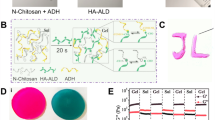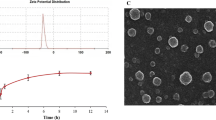Abstract
The previously developed gelatin/silk fibroin microspheres were loaded with curcumin and applied for anti-inflammatory treatment in monosodium iodoacetate (MIA)-induced osteoarthritis (OA) in a rat model. The MIA-induced OA rats received a single intra-articular injection with gelatin or gelatin/silk fibroin (30/70) microspheres encapsulating curcumin. The therapeutic effects of treatment groups [concentration of interleukin-6 (IL-6) in blood serum, radiographic and the histological grading on articular joint] were compared with those of normal saline treated OA and normal rats. The result showed that both microsphere groups reduced the level of IL-6 in serum after 1 week of treatment. The gelatin/silk fibroin (30/70) microspheres encapsulating curcumin delayed the cellular destruction in articular joint and synovial tissue after 8 weeks. The radiographic and histological gradings on articular cartilage lesion and synovial tissue change of rats treated with gelatin/silk fibroin (30/70) microspheres encapsulating curcumin were close to those of the normal rats. It was explained that the slow-degrading gelatin/silk fibroin (30/70) microspheres released curcumin for extended period and showed a prolonged anti-inflammatory effect, compared to the fast-degrading gelatin microspheres. This delivery system of curcumin was suggested to be applied for localized treatment of anti-inflammatory in OA with minimal invasion.





Similar content being viewed by others
References
Aggarwal BB, Harikumar KB (2009) Potential therapeutic effects of curcumin, the anti-inflammatory agent, against neurodegenerative, cardiovascular, pulmonary, metabolic, autoimmune and neoplastic diseases. Int J Biochem Cell B 41:40–59
Aggarwal BB, Sung B (2009) Pharmacological basis for the role of curcumin in chronic diseases: an age-old spice with modern targets. Trends Pharmacol Sci 30:85–94
Al-Saffar FJ, Ganabadi S, Fakuraz S (2011) Response of Channa striatus extract against monosodium iodoacetate induced osteoarthritis in rats. J Anim Vet Adv 10:460–469
Altman RD, Akermark C, Beaulieu AD, Schnitzer T (2004) Efficacy and safety of a single intra-articular injection of non-animal stabilized hyaluronic acid (NASHA) in patients with osteoarthritis of the knee. Osteoarthr Cartil 12:642–649
Anand P, Kunnumakkara AB, Newman RA, Aggarwal BB (2007) Bioavailability of curcumin: problems and promises. Mol Pharm 4:807–818
Arden N, Nevitt MC (2006) Osteoarthritis: epidemiology. Best Pract Res Clin Rheumatol 20:3–25
Brandt JM, Brière LK, Marr J, MacDonald SJ, Bourne RB, Medley JB (2010) Biochemical comparisons of osteoarthritic human synovial fluid with calf sera used in knee simulator wear testing. J Biomed Mater Res Part A 94:961–971
Cao Y, Wang B (2009) Biodegradation of silk biomaterials. Int J Mol Sci 10:1514–1524
Chadjichristos C, Ghayor C, Kypriotou M, Martin G, Renard E, Ala-Kokko L et al (2003) Sp1 and Sp3 transcription factors mediate interleukin-1 beta down-regulation of human type II collagen gene expression in articular chondrocytes. J Biol Chem 278:39762–39772
Combe R, Bramwell S, Field MJ (2004) The monosodium iodoacetate model of osteoarthritis: a model of chronic nociceptive pain in rat. Neurosci Lett 370:236–240
D’Anjou MA, Moreau M, Troncy E, Pelletier JM, Abram F, Raynauld JP et al (2008) Osteophytosis, subchondral bone sclerosis, joint effusion and soft tissue thickening in canine experimental stifle osteoarthritis: comparison between 1.5 T magnetic resonance imaging and computed radiography. Vet Surg 37:166–177
Deodhar SD, Sethi R, Srimal RC (1980) Preliminary study on antirheumatic activity of curcumin (diferuloyl methane). Indian J Med Res 71:632–634
Fan J, Myant C, Underwood R, Cann P (2012) Synovial fluid lubrication of artificial joints: protein film formation and composition. Faraday Discuss 156:69–85
Ghosh S, Choudhury D, Roy T, Mamat AB, Masjuki HH, Murphy BP (2015) Tribological investigation of diamond-like carbon coated micro-dimpled surface under bovine serum and osteoarthritis oriented synovial fluid. Sci Technol, Adv Mater, p 16
Guerne PA, Carson DA, Lotz M (1990) IL-6 production by human articular chondrocytes. Modulation of its synthesis by cytokines, growth factors, and hormonesin vitro. J Immunol 144:499–505
Guzman RE, Evans MG, Bove S, Morenko B, Kilgore K (2003) Mono-iodoacetate-induced histologic changes in subchondral bone and articular cartilage of rat femorotibial joints: an animal model of osteoarthritis. Toxicol Pathol 31:619–624
Henrotin Y, Clutterbuck AL, Allaway D, Lodwig EM, Harris P, Mathy-Hartert M et al (2010) Biological actions of curcumin on articular chondrocytes. Osteoarthr Cartil 18:141–149
Houard X, Goldring MB, Berenbaum F (2013) Homeostatic mechanisms in articular cartilage and role of inflammation in osteoarthritis. Curr Rheumatol Rep 15:375
Kean WF, Buchanan WW (2005) The use of NSAIDs in rheumatic disorders 2005: a global perspective. Inflammopharmacology 13:343–370
Lee Y, Pai M, Brederson JD, Wilcox D, Hsieh G, Jarvis MF et al (2011) Monosodium iodoacetate-induced joint pain is associated with increased phosphorylation of mitogen activated protein kinases in the rat spinal cord. Mol Pain 7:39
Li M, Ogiso M, Minoura N (2003) Enzymatic degradation behavior of porous silk fibroin sheets. Biomaterials 24:357–365
Loeser RF (2006) Molecular mechanisms of cartilage destruction: mechanics, inflammatory mediators, and aging collide. Arthritis Rheumatol 54:1357–1360
Moon DO, Kim MO, Choi YH, Park YM, Kim GY (2010) Curcumin attenuates inflammatory response in IL-1β-induced human synovial fibroblasts and collagen-induced arthritis in mouse model. Int Immunopharmacol 10:605–610
Moon SJ, Jeong JH, Jhun JY, Yang EJ, Min JK, Choi JY et al (2014) Ursodeoxycholic acid ameliorates pain severity and cartilage degeneration in monosodium iodoacetate-induced osteoarthritis in rats. Immune Netw 14:45–53
Nieminen HJ, Ylitalo T, Karhula S, Suuronen JP, Kauppinen S, Serimaa R et al (2015) Determining collagen distribution in articular cartilage using contrast-enhanced micro-computed tomography. Osteoarthr Cartil 23:1613–1621
Park C, Moon DO, Choi IW, Choi BT, Nam TJ, Rhu CH et al (2007) Curcumin induces apoptosis and inhibits prostaglandin E(2) production in synovial fibroblasts of patients with rheumatoid arthritis. Int J Mol Med 20:365–372
Park S, Lee LR, Seo JH, Kang S (2016) Curcumin and tetrahydrocurcumin both prevent osteoarthritis symptoms and decrease the expressions of pro-inflammatory cytokines in estrogen-deficient rats. Genes Nutr 11:2
Pitcher T, Sousa-Valente J, Malcangio M (2016) The monoiodoacetate model of osteoarthritis pain in the mouse. J Vis Exp 111:e53746
Ratanavaraporn J, Kanokpanont S, Damrongsakkul S (2014) The development of injectable gelatin/silk fibroin microspheres for the dual delivery of curcumin and piperine. J Mater Sci: Mater Med 25:401–410
Schmitz N, Laverty S, Kraus VB, Aigner T (2010) Basic methods in histopathology of joint tissues. Osteoarthr Cartil 18:S113–S116
Shahani K, Swaminathan SK, Freeman D, Blum A, Ma L, Panyam J (2010) Injectable sustained release microparticles of curcumin: a new concept for cancer chemoprevention. Cancer Res 70:4443–4452
Shakibaei M, John T, Schulze TG, Lehmann I, Mobasheri A (2007) Suppression of NF-κB activation by curcumin leads to inhibition of expression of cyclo-oxygenase-2 and matrix metalloproteinase-9 in human articular chondrocytes: implications for the treatment of osteoarthritis. Biochem Pharmacol 73:1434–1445
Shimi T, Uchi T, Bara T, Yamaguchip T, Akakibara Y, Toh H et al (1994) Effects of high-molecular-weight sodium hyaluronate on experimental osteoarthrosis induced by the resection of rabbit anterior cruciate ligament. Clin Orthop Relat Res 298:296–304
Sinusas K (2012) Osteoarthritis: diagnosis and treatment. Am Fam Phys 85:49–56
Verdera AB, Bernal VC, Levenfeld JO, Sainz CC (2013) Efficacy and safety of a single intra-articular injection of 2% hyaluronic acid plus mannitol injection in knee osteoarthritis over a 6-month period. Rev Espar Circu Ortop Traumatol 56:274–280
Wallace JL, Syer S, Denou E, de Palma G, Vong L, McKnight W et al (2011) Proton pump inhibitors exacerbate NSAID-induced small intestinal injury by inducing dysbiosis. Gastroenterology 141:1314–1322
Acknowledgements
This research was supported by the Ratchadaphiseksomphot Endowment Fund Part of the "Research Grant for New Scholar CU Researcher's Project (RGN_2558_019_02_21) and Faculty of Engineering, Chulalongkorn University.
Author information
Authors and Affiliations
Corresponding author
Rights and permissions
About this article
Cite this article
Ratanavaraporn, J., Soontornvipart, K., Shuangshoti, S. et al. Localized delivery of curcumin from injectable gelatin/Thai silk fibroin microspheres for anti-inflammatory treatment of osteoarthritis in a rat model. Inflammopharmacol 25, 211–221 (2017). https://doi.org/10.1007/s10787-017-0318-3
Received:
Accepted:
Published:
Issue Date:
DOI: https://doi.org/10.1007/s10787-017-0318-3




